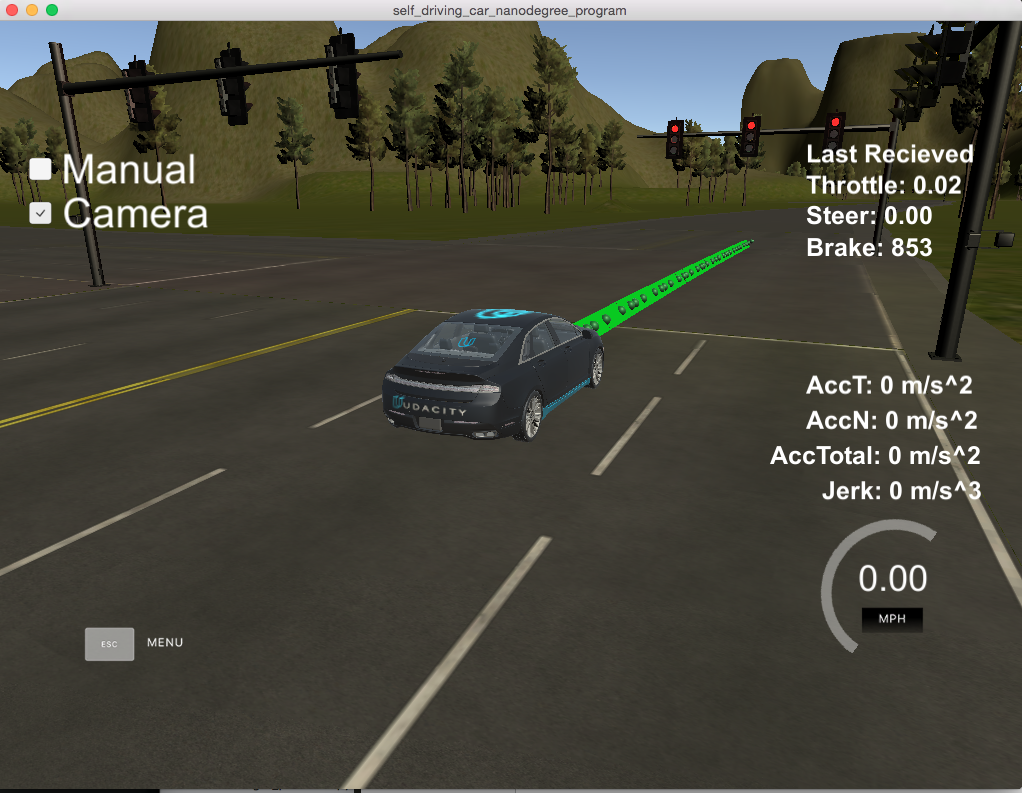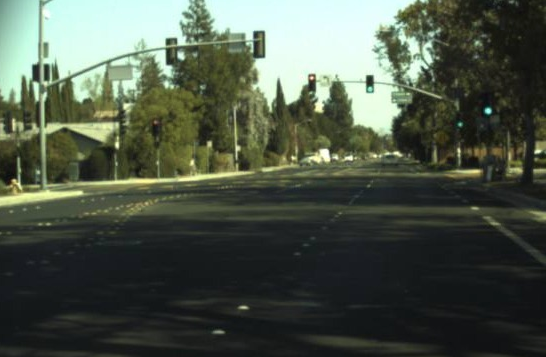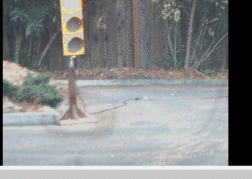This is the project repo for the final project of the Udacity Self-Driving Car Nanodegree: Programming a Real Self-Driving Car. For more information about the project, see the project introduction here.
| Name | |
|---|---|
| Kevin Sepehri | kevinsepehri@gmail.com |
| Lajos Kamocsay | panka.nospam@gmail.com |
| Mike Challis | gardenermike@gmail.com |
| Rafael Barreto | rafaelbarretorb@gmail.com |
The purpose of this node is to publish a fixed number of waypoints (40) ahead of the vehicle with the correct target velocities, depending on traffic lights and obstacles.
/ros/src/waypoint_updater/waypoint_updater.py
/current_pose: The current position of the car.
/base_waypoints: One time load of waypoints from the whole track.
/current_velocity: The current velocity of the car.
/traffic_waypoint: Waypoint index of the closest red traffic light.
Not subscribing to obstacle waypoint as it's not yet part of the project
/final_waypoints: Total number of waypoints are based on LOOKAHEAD_WPS variable. If the car is approaching a red light it reduces these velocities to come to a stop by the stop line.
This node subscribes to various topics and controllers to provide appropriate throttle, brake, and steering commands.
/ros/src/twist_controller/dbw_node.py
/twist_cmd: Twist commands that describe linear and angular velocities
/current_velocity: The current velocity of the car
/vehicle/dbw_enabled: Switching between manual and DBW control
/tl_detector_ready: Boolean that returns true once the traffic light detector is ready. If the detector is not ready the car brakes and sleeps.
/vehicle/throttle_cmd: Throttle commands.
/vehicle/brake_cmd: Brake commands.
/vehicle/steering_cmd: Steering commands.
This node uses Keras MobileNet to detect traffic lights and publishes the upcoming light waypoint along with a boolean for knowing if the model is ready.
/ros/src/tl_detector/tl_detector.py
/current_pose: The current position of the car.
/base_waypoints: One time load of waypoints from the whole track.
/vehicle/traffic_lights: Location of the traffic light in 3D map space.
/image_color: Color image provided by camera.
/tl_detector_ready: Boolean to notify other nodes that the keras model is loaded.
/traffic_waypoint: Waypoint index of the closest red traffic light.
The model was trained with a subset of the Bosch data and simulator images. The data is then augmented and evaluated. The model gets 95.7% accuracy on the combined simulator and bosch data, with 99.7% accuracy on the simulator training data.
Sample Bosch Training Image
Sample Camera Bag Image
/traffic-light-detection/train.py
image_size = (224, 224, 3)
batch_size = 16
num_classes = 4
epochs = 96
base_model = MobileNet(
alpha=0.25, # adjust down to make model smaller/faster by reducing filter count
depth_multiplier=1, # adjust down to make model smaller/faster by reducing resolution per layer
weights='imagenet',
#weights=None,
include_top=False,
#classes=num_classes,
input_shape=image_size
)It also augments the data randomly
# augment data
# rotate up to 2 degrees
image = preprocess.random_rotation(image, 2, row_axis=0, col_axis=1, channel_axis=2)
# randomly shift up to 20%
image = preprocess.random_shift(image, 0.2, 0.2, row_axis=0, col_axis=1, channel_axis=2)
# randomly zoom in up to 20%
image = preprocess.random_zoom(image, (0.8, 0.8), row_axis=0, col_axis=1, channel_axis=2)
#adjust brightness
image = preprocess.random_brightness(image, (0.8, 1.2))
# randomly flip horizontally
if np.random.random() > 0.5:
image = preprocess.flip_axis(image, 1)We ran into performance issues between the simulator and ROS so we tried the following optimizations:
- Reducing lookahead waypoints from 100 to 40
- Only send images to the model if the car is 100 to 25 waypoints from the light
Please use one of the two installation options, either native or docker installation.
-
Be sure that your workstation is running Ubuntu 16.04 Xenial Xerus or Ubuntu 14.04 Trusty Tahir. Ubuntu downloads can be found here.
-
If using a Virtual Machine to install Ubuntu, use the following configuration as minimum:
- 2 CPU
- 2 GB system memory
- 25 GB of free hard drive space
The Udacity provided virtual machine has ROS and Dataspeed DBW already installed, so you can skip the next two steps if you are using this.
-
Follow these instructions to install ROS
- ROS Kinetic if you have Ubuntu 16.04.
- ROS Indigo if you have Ubuntu 14.04.
-
- Use this option to install the SDK on a workstation that already has ROS installed: One Line SDK Install (binary)
-
Download the Udacity Simulator.
Build the docker container
docker build . -t capstoneRun the docker file
docker run -p 4567:4567 -v $PWD:/capstone -v /tmp/log:/root/.ros/ --rm -it capstoneTo set up port forwarding, please refer to the instructions from term 2
- Clone the project repository
git clone https://github.com/udacity/CarND-Capstone.git- Install python dependencies
cd CarND-Capstone
pip install -r requirements.txt- Make and run styx
cd ros
catkin_make
source devel/setup.sh
roslaunch launch/styx.launch- Run the simulator
- Download training bag that was recorded on the Udacity self-driving car.
- Unzip the file
unzip traffic_light_bag_file.zip- Play the bag file
rosbag play -l traffic_light_bag_file/traffic_light_training.bag- Launch your project in site mode
cd CarND-Capstone/ros
roslaunch launch/site.launch- Confirm that traffic light detection works on real life images


